amber2461 wrote:Newjohn
I am absolutely green with envy of your shrimp motels ... ~sigh~
Rebirth of the Invert Room
Moderator: Mustafa
Re: Rebirth of the Invert Room
Wow, you have not been here for ages! Good to "see" you again. 
Re: Rebirth of the Invert Room
All this hard work, John...I'm sure you can't wait to see some shrimp running around there sooner than later to get rewarded for your efforts. 
Re: Rebirth of the Invert Room
" All this hard work "Mustafa wrote:All this hard work, John...I'm sure you can't wait to see some shrimp running around there sooner than later to get rewarded for your efforts.
I find this relaxing
It is stress relief from a Stressful job
Yes, I am eagerly awaiting my tanks to be swarming with Shrimp." I'm sure you can't wait to see some shrimp running around "
2 of my Shrimp Tanks are already Cycled.
Yes, they will house Shrimp.
But, I want my Tanks to be Seasoned and just not Cycled.
When it comes to keeping Shrimp,
There is a Big Difference between Cycled & Seasoned !
To help move things along,
I have 2 Adult Marmokreb Crayfish in one tank.
And, 12 young Gelius Barbs in the other.
20 Ghost/Glass Shrimp will be going into the third tank tonight.
No, the Ghost Shrimp are not just to season the tank.
I like to raise the Larva to adulthood and I need to work on a higher percentage of survival.
It will be good practice for when I start trying to raise Salt Water Larva.
Re: Rebirth of the Invert Room
Of course, compared to work it's relaxing. But actually seeing shrimp in the tanks and breeding them (i.e. what follows your "hard work") is *even* more relaxing.Newjohn wrote:I find this relaxing,
It is stress relief from a Stressful job.
The importance of this cannot be emphasized often enough...But, I want my Tanks to be Seasoned and just not Cycled.
I fully understand. I enjoy Palaemonetes paludosus (which is, I assume, what you have) a lot myself. It's a very interesting shrimp...and not that commonly available actually (although when it is available in pet stores it tends to be dirt cheap...and sold as a feeder, which, of course, means that a trillion shrimp are in a tiny tank in really bad shape.)No, the Ghost Shrimp are not just to season the tank.
I like to raise the Larva to adulthood and I need to work on a higher percentage of survival.
Yes, although better practice would be to raise some Macrobrachium lanchesteri larvae. The American glass shrimp larvae metamorphose into benthic postlarvae within a week...and...although they can and do eat food if there is food (which makes them settle earlier and at a larger size) research suggests that P. plaudosus larvae can turn into postlarvae even without feeding as larvae. (This fact is pretty much unknown in the hobby). M. lanchesteri larvae definitely need food and they seem to need about 4 weeks to metamorphose into postlarvae (give or take a few days depending on temperature). Unfortunately, that shrimp is not commonly available in the US at all. I have a a breeding group here with tons of females running around. I haven't had the space, yet, to methodically breed them (in larger numbers), but I'll probably set up a tank just for raising their larvae. Then I can send you some young to practice with.It will be good practice for when I start trying to raise Salt Water Larva.
Re: Rebirth of the Invert Room
Of course, compared to work it's relaxing. But actually seeing shrimp in the tanks and breeding them (i.e. what follows your "hard work") is *even* more relaxing.
RelaxingBut actually seeing shrimp in the tanks and breeding them (i.e. what follows your "hard work") is *even* more relaxing.
That is the reason I have this in the Invert Room.
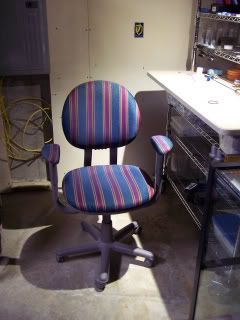
If my LazyBoy fit in between the racks, it would be there instead of the Rolling Office Chair.
I am not sure if there are Palaemonetes paludosus.I fully understand. I enjoy Palaemonetes paludosus (which is, I assume, what you have) a lot myself. It's a very interesting shrimp...and not that commonly available actually (although when it is available in pet stores it tends to be dirt cheap...and sold as a feeder, which, of course, means that a trillion shrimp are in a tiny tank in really bad shape.)
Pictures to follow.
Yes, they were sold as feeders.
There was one small small berried female in the group.
I had a few Tail Hangers, but I knew they would not last long, Newly Cylced Tank.
Yes, although better practice would be to raise some Macrobrachium lanchesteri larvae.
Yes, I would have to agree with you,I guess to be appreciated they would have to be available first for people to appreciate them.....
Re: Rebirth of the Invert Room
I'm pretty sure they are. Close to 100% of all feeder shrimp in the US are Palaemonetes paludosus...the pictures will probably confirm this.
Newjohn wrote: I am not sure if there are Palaemonetes paludosus.
Pictures to follow.
Yes, they were sold as feeders.
Re: Rebirth of the Invert Room
NO MORE BUCKETS
For Water Changes.
There was a little more progress in the Invert Room this weekend.
( 2 ) Racks Systems are now connected to the Sewer System.
Never mind the Dates on the pictures, I changed the batteries in the camera and this was the default date.

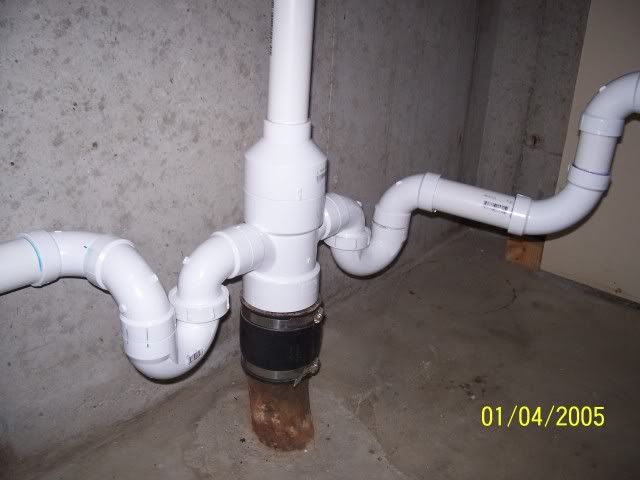
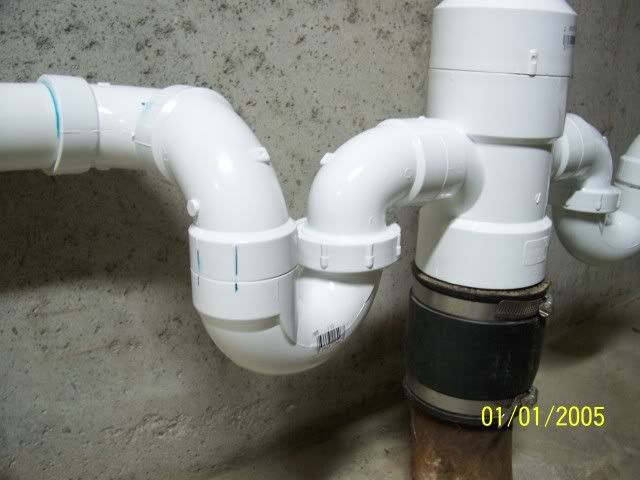
If you do not already know, this is a P-Trap.
It is used to prevent Sewer Gas from getting into your house.
Water remains in the lower Elbow witch acts as a "Plug". Water can exit, but Sewer Gas can not pass through.
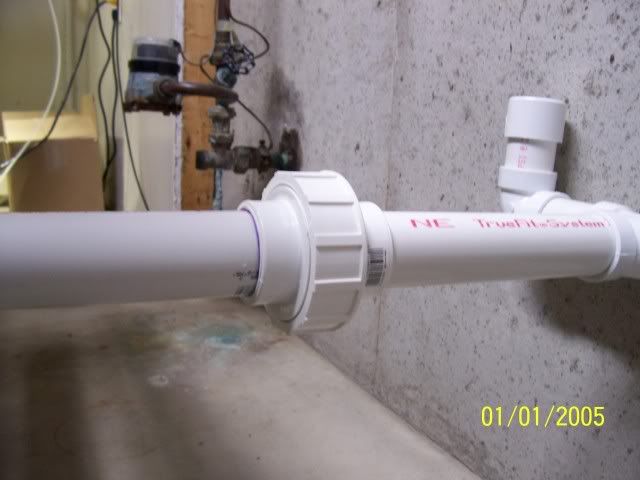
Another Union, for easier Disconnection.
I may want to change things around in the future.
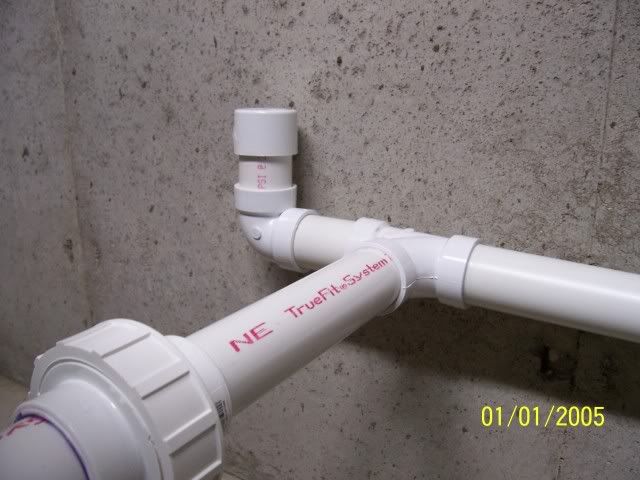
A Capped Stubbed end.
This will be the Drain Connection for 2 future Rack Set-Ups.
I used Silicone instead of PVC Cement for easy removal.
I will hopefully purchase a couple more Heaters this week.
My basement is a little cold and before I can pick up any more Shrimp, I will have to have warmer water to house them in.
There are a couple listed in the PETSHRIMP STORE that have caught my interest.
Now that the Drain System is complete.
I will be working on the Water Change / Drip System.
I will be using 1/4" water line & John Guest Quick Disconnect Unions.
Pictures to follow.
For Water Changes.
There was a little more progress in the Invert Room this weekend.
( 2 ) Racks Systems are now connected to the Sewer System.
Never mind the Dates on the pictures, I changed the batteries in the camera and this was the default date.



If you do not already know, this is a P-Trap.
It is used to prevent Sewer Gas from getting into your house.
Water remains in the lower Elbow witch acts as a "Plug". Water can exit, but Sewer Gas can not pass through.

Another Union, for easier Disconnection.
I may want to change things around in the future.

A Capped Stubbed end.
This will be the Drain Connection for 2 future Rack Set-Ups.
I used Silicone instead of PVC Cement for easy removal.
I will hopefully purchase a couple more Heaters this week.
My basement is a little cold and before I can pick up any more Shrimp, I will have to have warmer water to house them in.
There are a couple listed in the PETSHRIMP STORE that have caught my interest.
Now that the Drain System is complete.
I will be working on the Water Change / Drip System.
I will be using 1/4" water line & John Guest Quick Disconnect Unions.
Pictures to follow.
Re: Rebirth of the Invert Room
Those PVC unions are a great idea. One question, though, won't the rubber "gasket" in the union deteriorate at some point? If that happens, wouldn't you have to cut the union out and replace it?
Re: Rebirth of the Invert Room
Seeing that this is not a pressurized system, deterioration should be kept to a minimum.One question, though, won't the rubber "gasket" in the union deteriorate at some point?
If for some reason I did have to replace a Rubber O-Ring, there is enough play in the drain system to spread the Union apart and access the O-Ring.wouldn't you have to cut the union out and replace it?
Re: Rebirth of the Invert Room
Ahhh...ok. Makes sense. I guess I'll be using unions in my future projects from now on, too. 
Re: Rebirth of the Invert Room
wow john ,
very Nice.
Myself i am preparing to make a come back to the hobby after being out for a while.
i am planning my comeback for this summer , since i still a few things to sort out
but mustafa give me the little kick i need to move a bit (thansk mustafa)
(thansk mustafa) 
dont know in wich direction iw ill go yet ( cray, purely shrimp, snail, or a bit of everything) , but for sure it will be inverts
very happy to be back
Z.
very Nice.
Myself i am preparing to make a come back to the hobby after being out for a while.
i am planning my comeback for this summer , since i still a few things to sort out
but mustafa give me the little kick i need to move a bit
dont know in wich direction iw ill go yet ( cray, purely shrimp, snail, or a bit of everything) , but for sure it will be inverts
very happy to be back
Z.
Re: Rebirth of the Invert Room
Hey zapisto
It is nice to see you back.
I have been kicking myself, ever since I got out a few years ago.
It is nice to see you back.
Mustafa did not have to give me a kick,but mustafa give me the little kick
I have been kicking myself, ever since I got out a few years ago.
Looking forward to it.Myself i am preparing to make a come back to the hobby after being out for a while.
Re: Rebirth of the Invert Room
I hope things are chugging along in your invert room, John. I am looking forward to seeing some more pictures when your tanks are inhabited with lots of inverts.
Zapisto! I'm glad you're back! We absolutely need more serious hobbyists. Even if the new ones are "old." Now we have Canada on board again, great!
Now we have Canada on board again, great!  .
.
Zapisto! I'm glad you're back! We absolutely need more serious hobbyists. Even if the new ones are "old."
Re: Rebirth of the Invert Room
Chugging along is about right.I hope things are chugging along in your invert room, John
Not a lot of progress, but I have the Third Tank up and running.
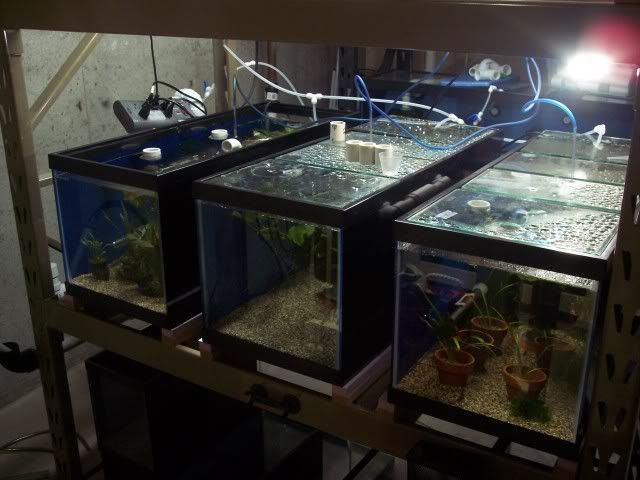
I have the 4th Tank Drilled & Painted, which will be the start of the Top Row of Tanks.
Once I have the the Tank Supports for the top row installed, I can start to clean up the Air & Water Lines and finalize the Lighting.
Re: Rebirth of the Invert Room
I like how you have multiple glass sections as the cover for your tanks. Makes maintenance a lot easier if you don't have to constantly remove a large, one or two piece top to reach into the tank. 


